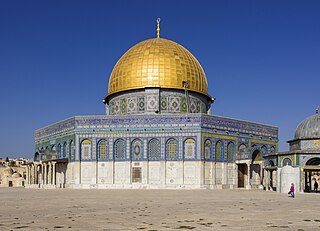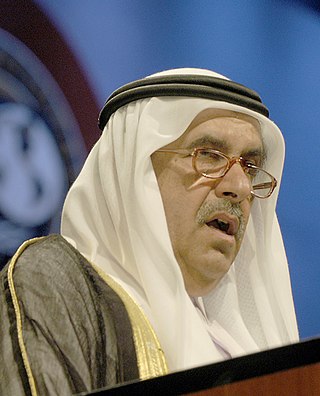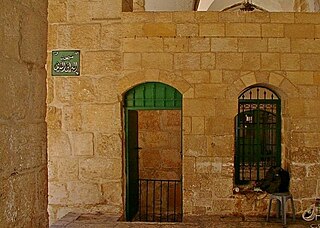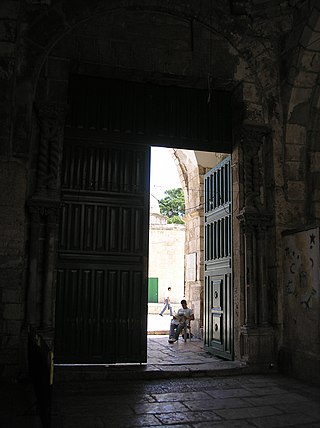
Aelia Capitolina was a Roman colony founded during the Roman emperor Hadrian's visit to Judaea in 129/130 CE. It was founded on the ruins of Jerusalem, which had been almost totally razed after the siege of 70 CE. This act marked a significant transformation of the city from a Jewish metropolis to a small pagan settlement dedicated to the cult of Capitoline Jupiter.

The Temple Mount, also known as The Noble Sanctuary, al-Aqsa Mosque compound, or simply al-Aqsa, and sometimes as Jerusalem's holyesplanade, is a hill in the Old City of Jerusalem that has been venerated as a holy site for thousands of years, including in Judaism, Christianity and Islam.

The Dome of the Rock is an Islamic shrine at the center of the Al-Aqsa mosque compound on the Temple Mount in the Old City of Jerusalem. It is the world's oldest surviving work of Islamic architecture, the earliest archaeologically attested religious structure to be built by a Muslim ruler and its inscriptions contain the earliest epigraphic proclamations of Islam and of the Islamic prophet Muhammad.

The Well of Souls, is a partly natural, partly man-made cave located inside the Foundation Stone under the Dome of the Rock shrine on the Temple Mount in Jerusalem. During the Crusader period, it was known to Christians as the "Holy of Holies", referring to the inner sanctum of the former Jewish Temple, which, according to modern scholarship, was probably located on top of the Foundation Stone.

The Buraq is a supernatural equine-esque creature in Islamic tradition that served as the mount of the Islamic prophet Muhammad during his Isra and Mi'raj journey from Mecca to Jerusalem and up through the heavens and back by night. Although never stated to have wings, it is almost always depicted as a pegasus-like being. The Buraq is also said to have transported certain prophets such as Abraham over long distances within a moment's duration.

Names of Jerusalem refers to the multiple names by which the city of Jerusalem has been known and the etymology of the word in different languages. According to the Jewish Midrash, "Jerusalem has 70 names". Lists have been compiled of 72 different Hebrew names for Jerusalem in Jewish scripture.

The Israʾ and Miʿraj are the two parts of a Night Journey that Muslims believe the Islamic prophet Muhammad took during a single night around the year AD 621. Within Islam, the majority of Islamic scholars claim that the journey was both a physical and spiritual one. Islamic tradition believes a brief mention of the story is found in the 17th surah (chapter) of the Quran, called al-Isra', while details of the story are found in the hadith.
Shams al-Din Abu Abd Allah Muhammad ibn Ahmad ibn Abi Bakr, commonly known by the nisbaal-Maqdisi or al-Muqaddasī, was a medieval Arab geographer, author of The Best Divisions in the Knowledge of the Regions and Description of Syria .
Maqdisi is an Arabic nisba referring to a Jerusalemite. It is derived from Bayt al-Maqdis, an Arabic name for Jerusalem, by way of the Hebrew Beit HaMikdash, the Temple in Jerusalem. Today, the common Arabic name of Jerusalem is al-Quds.

Ez-Zitouna University is a public ancient medieval university in Tunis, Tunisia. The university originates in the Al-Zaytuna Mosque, founded at the end of the 7th century or in the early 8th century, which developed into a major Islamic centre of learning in North Africa. It consists of the Higher Institute of Theology and the Higher Institute of Islamic Civilisation in Tunis and a research institution, the Center of Islamic Studies, in Kairouan.

Sheikh Hamdan bin Rashid Al Maktoum was an Emirati politician, the deputy ruler of Dubai and the minister of finance and industry of the United Arab Emirates (UAE). He was the second son of the late ruler Rashid bin Saeed Al Maktoum. Hamdan bin Rashid Al Maktoum was the head of the UAE's delegation at the International Monetary Fund and the OPEC Fund.

The Temple Mount, a holy site in the Old City of Jerusalem, also known as the al-Ḥaram al-Sharīf or Al-Aqsa, contains twelve gates. One of the gates, Bab as-Sarai, is currently closed to the public but was open under Ottoman rule. There are also six other sealed gates. This does not include the Gates of the Old City of Jerusalem which circumscribe the external walls except on the east side.

The al-Buraq Mosque is a subterranean musalla next to the Buraq Wall, near the southwest corner of the Masjid al-Aqsa compound in the Old City of Jerusalem. This mosque is called al-Buraq Mosque because of a ring that is nailed to its wall where Muslims believe Muhammad tied the Buraq that carried him from the al-Haram Mosque to the al-Aqsa Mosque during the Night Journey.

Temple denial is the claim that the successive Temples in Jerusalem either did not exist or they did exist but were not constructed on the site of the Temple Mount, a claim which has been advanced by Islamic political leaders, religious figures, intellectuals, and authors.
Al-Ji'rana is a village in Makkah Province, in western Saudi Arabia. It is located 18 miles northeast of Mecca.

The Islamization of Jerusalem refers to the process through which Jerusalem and its Old City acquired an Islamic character and, eventually, a significant Muslim presence. The foundation for Jerusalem's Islamization was laid by the Muslim conquest of the Levant, and began shortly after the city was besieged and captured in 638 CE by the Rashidun Caliphate under Umar ibn al-Khattab, the second Rashidun caliph. The second wave of Islamization occurred after the fall of the Kingdom of Jerusalem, a Christian state that was established after the First Crusade, at the Battle of Hattin in 1187. The eventual fall of the Crusader states by 1291 led to a period of almost-uninterrupted Muslim rule that lasted for seven centuries, and a dominant Islamic culture was consolidated in the region during the Ayyubid, Mamluk and early Ottoman periods. Beginning in the late Ottoman era, Jerusalem’s demographics turned increasingly multicultural, and regained a Jewish-majority character during the late-19th and early-20th centuries that had not been seen since the Roman period, which largely ended the Jewish presence in the region.
Umar's Assurance, is an assurance of safety given by the Caliph Umar ibn al-Khattab to the people of Aelia, the Late Roman name for Jerusalem. Several versions of the Assurance exist, with different views of their authenticity.

Nabilah Lubis is an Indonesian philologist, writer, translator and lecturer. Nabilah is an Egyptian woman who was married by a Batak Mandailing man from Medan named Burhanuddin Umar Lubis, so she changed her last name to Nabilah Lubis.

The Gate of the Chain or Chain Gate is one half of a double gate, part of the gates to the Al-Aqsa Mosque compound on the Temple Mount in the Old City of Jerusalem. It was known early Islamic period Bāb Daud, which means David's Gate. It was also known as Bāb al-Maḥkama, Gate of the Law Court, named after the nearby Maḥkama in the Tankiziyya building.
Abu Bakr Muhammad ibn Ahmad al-Wasiti was the preacher (khatib) of al-Aqsa Mosque in 1019–1020, the year he wrote a treatise entitled Concerning the (religious) status of Jerusalem, better known as Fada'il Bayt al-Muqaddas, also spelled Fada'il al-Bayt al-Maqdis, literally "Merits/Virtues of Jerusalem".














